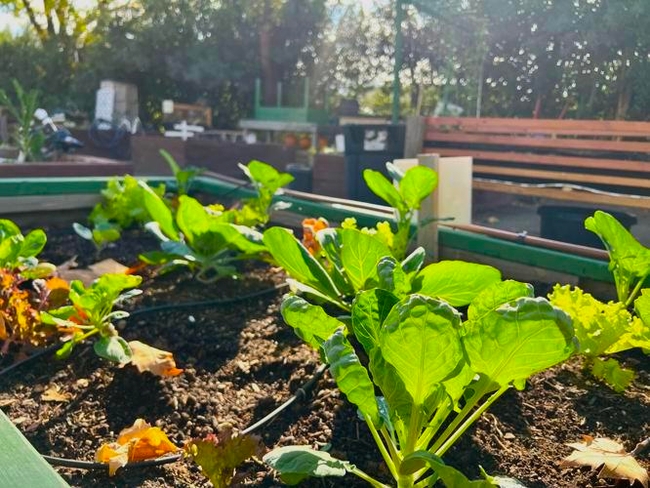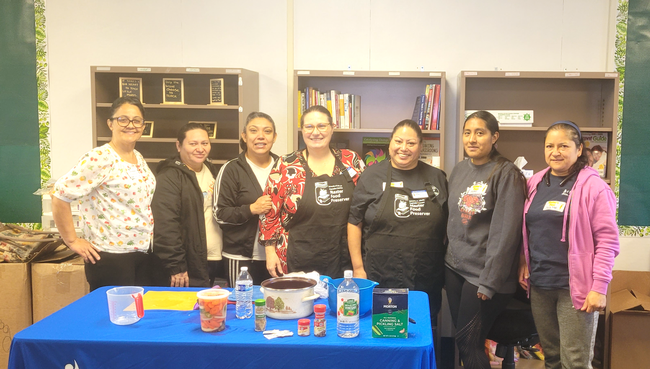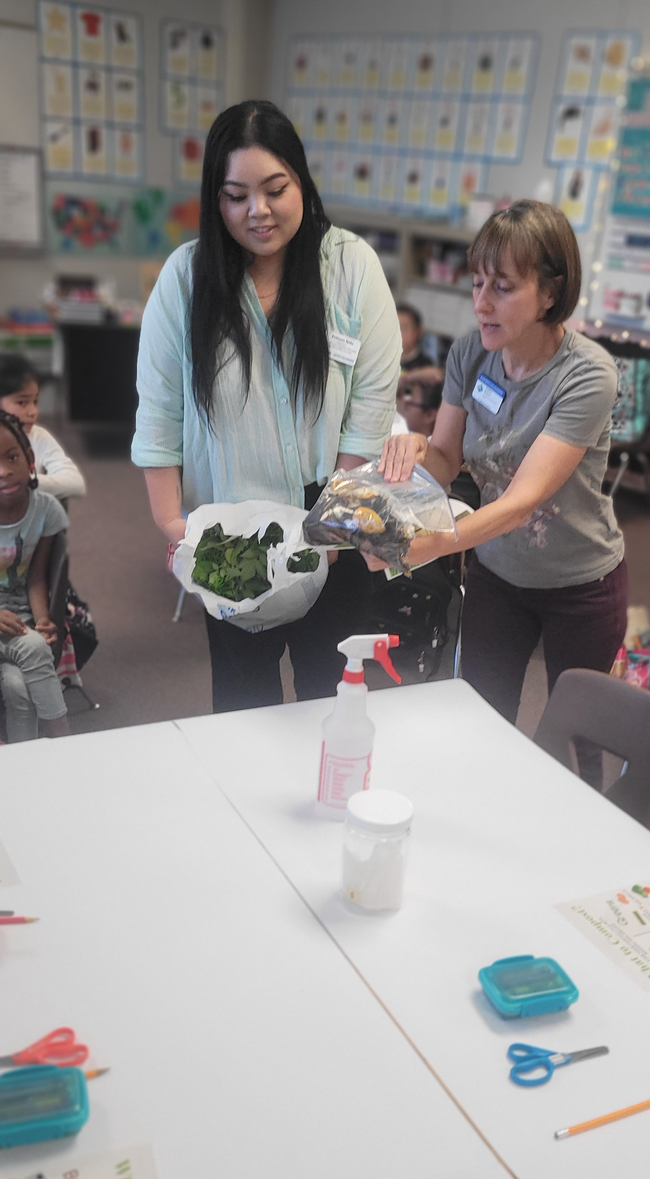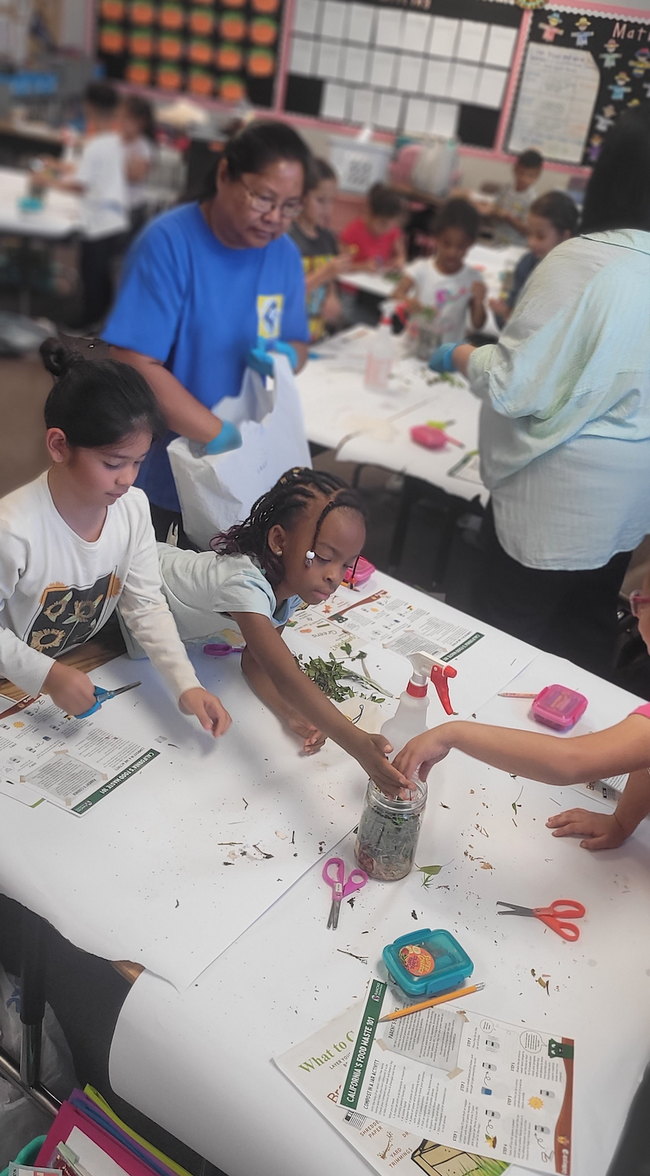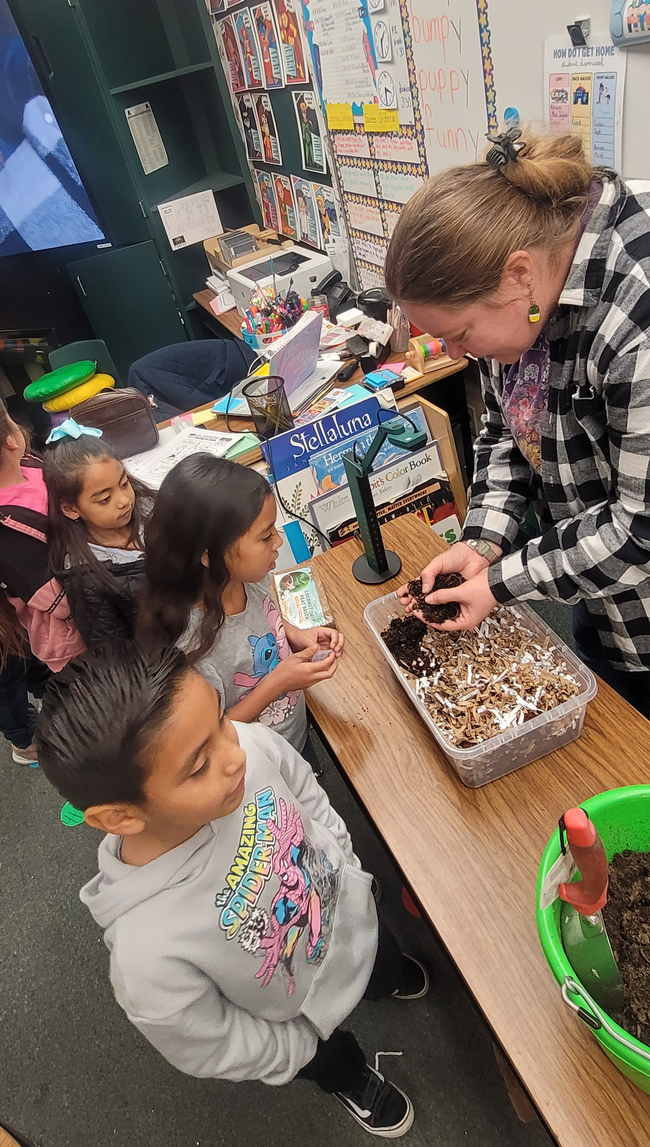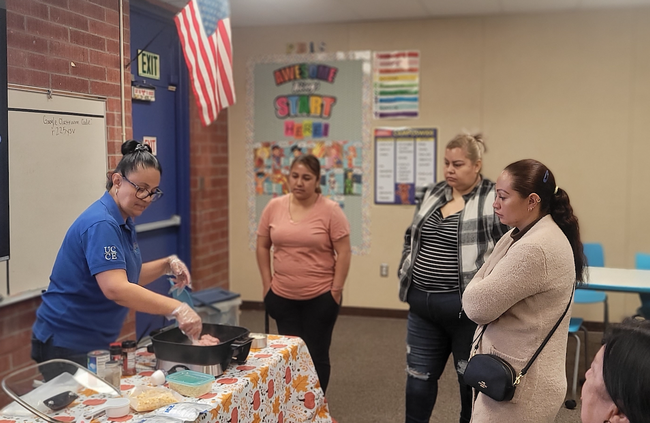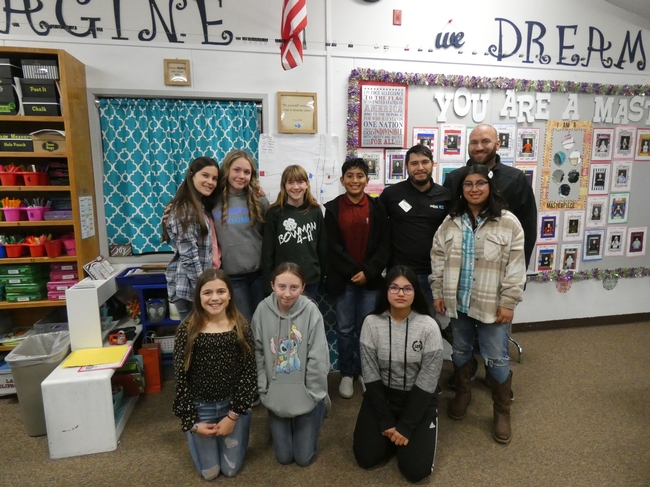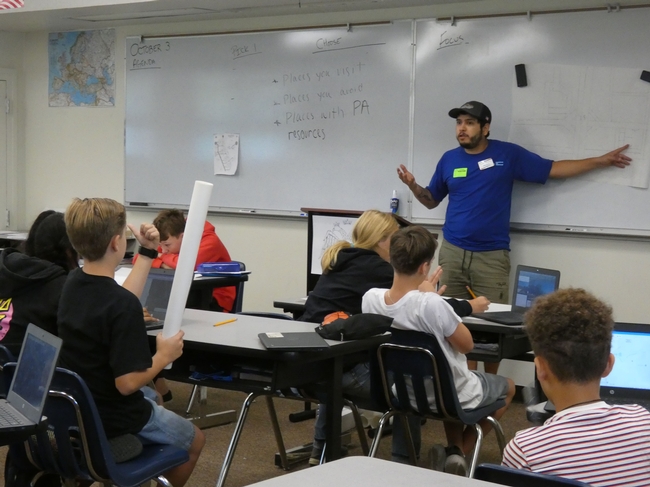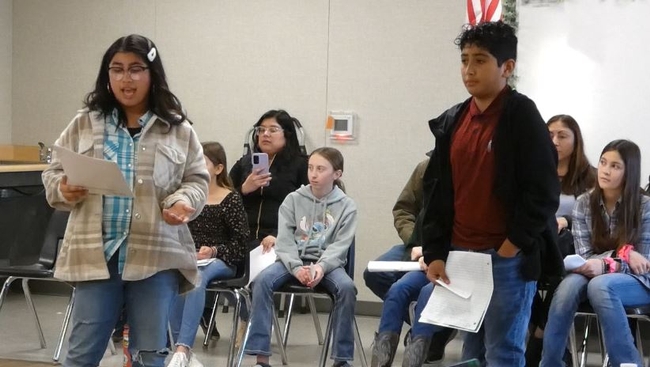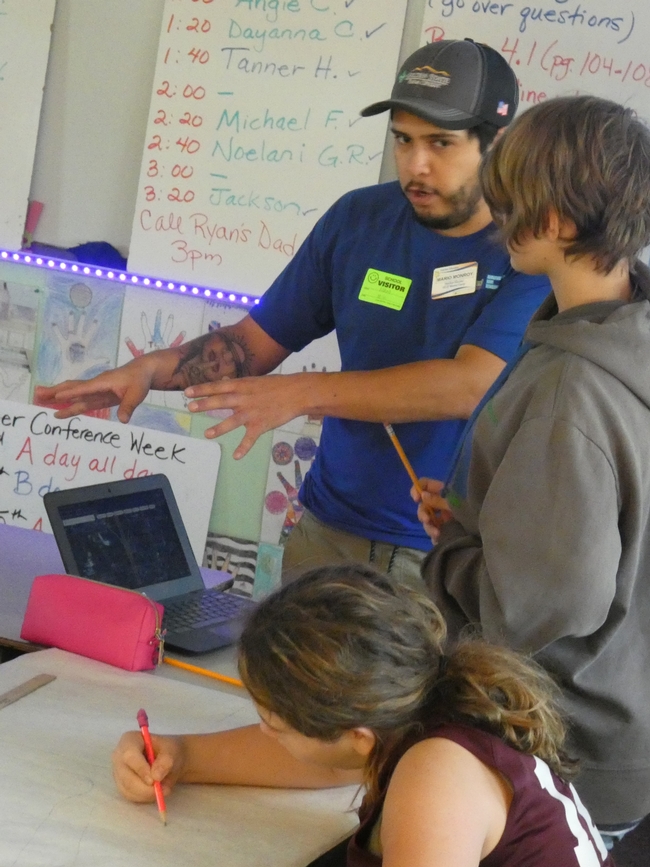- Author: Saoimanu Sope
Although training is required to become a University of California Master Gardener, the benefits of gardening can be experienced by anyone and everyone.
“As long as you're willing to get your hands dirty,” said Laurie Menosky, a UC Master Gardener volunteer in Orange County, “you can learn to grow all sorts of things.”
In early April, Menosky partnered with ETN Medical Infusion (a clinic in Orange County) and the Sustainability Program for Student Housing at UC Irvine to teach students how to grow tomatoes. Menosky welcomed all in attendance, including families with toddlers who seemed fascinated by the 60 tomato plants atop one of the tables in the room.
The UC Master Gardener Program is a part of UC Agriculture and Natural Resources. During her presentation, Menosky taught participants how to choose varieties that fit their taste and growing environment, how to cultivate a thriving environment, and how to control pests and diseases using integrated pest management practices.
“We have 16,000 residents at UCI and sustainability is one of our values. One of the ways we engage students is through on-campus gardens,” said Rachel Harvey, sustainability program manager for UCI Student Housing and a UC Master Gardener volunteer in Orange County.
UC Irvine has one teaching garden reserved for undergraduate learning, and three gardens operated and maintained by graduate students. “I was on the waiting list for a garden plot for a while, but it was totally worth the wait,” said Johanna Rinaman, a fifth-year Ph.D. student studying physical chemistry.
While the highlight of the event for many people was the opportunity to take a tomato plant home, another important takeaway was how gardening can be a good activity for your mental health. Sarah Nghiem, family medicine specialist at ETN Medical Infusion, who worked closely with Menosky, was instrumental in developing the mental health content for the day, encouraging attendees to attempt gardening with a mental health perspective.
Nghiem and her team received funding from the Orange County Health Care Agency through the Mental Health Services Act to work with transitional aged students (15-24 years-old) on understanding the importance of mental health, which led to the collaboration between UC Irvine, her alma mater, and the UC Master Gardeners of Orange County.
“I didn't do any gardening during the winter, and I felt a lot more anxious and depressed during that time,” Rinaman said. “I know gardening improves mental health because I've immediately felt a difference whenever I spend time with plants.”
Rinaman, whose father taught her a lot of what she knows about gardening, said that having access to a 4 feet by 6 feet plot to grow her own food is one of the many things she loves about UC Irvine.
Like Rinaman, Menosky turns to gardening to decompress, especially during the long days of summer. Teaching others about the physical and mental benefits of gardening gives her an opportunity to share her experience and, hopefully, help others find new ways to manage stress.
“We often have attendees come back years later telling us how our information has helped them and how much more they are enjoying their time in their gardens,” she said.
To conclude her presentation, Menosky instructed participants to line up for their own tomato plant. Attendees took their plants outside to transfer them from a small pot to a grow bag – a type of container that helps root structure development.
Cassie Ekwego, a third-year transfer student studying civil engineering, couldn't hide her excitement after carefully lifting her plant. “I don't think I realized how attentive you need to be when working with plants,” said Ekwego, reflecting on what she learned from Menosky's presentation.
Now that she has her own plant to care for in her own home, Ekwego is eager to put her new knowledge to the test. “I love tomatoes, but this is going to be a huge responsibility for me,” she said.
Randy Musser, UC Master Gardener program coordinator for Orange County, said that while he enjoys talking to avid gardeners, bringing gardening to new people in the community is special to him. “This tomato workshop is particularly exciting for me because it is an opportunity for the UC Master Gardeners to grow our connection to UCI and young people just starting off on their gardening journey,” said Musser.
With a generous contribution from UC Master Gardener volunteer Sheila Peterson, Musser was able to purchase enough supplies to help attendees, like Ekwego, jumpstart their gardening experience.
Students, whose stress levels can skyrocket throughout the school year, value opportunities to be outdoors, try something new and be in community. “The garden is a different type of classroom. It's a place where students can learn and experiment, hopefully in a way that reduces stress,” said Harvey of UCI Student Housing.
Ekwego, who tried gardening for the first time while volunteering at UC Irvine's teaching garden, is just one of the many students inspired by their experiences. “Gardening reminds me that it's OK to get my hands dirty,” Ekwego said.
- Author: Linda Forbes
Residents co-create the project with UC Master Gardeners and UC Master Food Preservers
Harmony Village is a 62-unit permanent supportive housing project in Yuba City for low-income individuals who are either homeless or precariously housed, with priority going to veterans, the disabled and the elderly. A grant from the UC Sustainable Agriculture Research and Education Program (SAREP) Small Grants Program enabled Sutter-Yuba County Director Whitney Brim-DeForest, UC Master Gardner Program Coordinator Cheryl Hoke and volunteers to work with residents of Harmony Village in creating a sustainable food program.
The goal of the project is for the residents to learn to supplement their food needs, develop self-sustainment skills and preserve their fresh food as they continue to strive toward a healthier lifestyle.
The funding allowed UC Master Gardeners to assist Harmony Village in obtaining garden supplies and setting up ten raised garden beds in addition to an irrigation system, plants and a shed. The project helped the residents expand a small community garden into a sizable garden that can provide more fresh produce. “Everyone was so happy on our build day," said Hoke. "They thanked us for caring.”
With guidance from UC Master Gardeners, participants identified the types of food they wanted to grow – carrots, broccoli, cabbage and radishes – and learned how to prepare the soil, plant vegetables, care for the plants, and harvest the crops. In a second set of workshops in November 2023, residents planted onions and garlic in the garden and learned how to make pumpkin butter.
Residents also learn from UC Master Food Preservers how to preserve their fresh food items for a longer shelf life and how to incorporate food they grow into their meals, which helps ensure that every crop is used to the maximum extent.
“Every single class I have attended has been relevant and so very informative! I'm 63 years old and never experienced such practical information in my life,” said a Harmony Village resident. “The work these ladies have done has been so impactful in the lives of this community. We have an incredible new food source because of these two ladies and the Master Gardeners.”
With support from Sutter County, Harmony Village residents also receive a share of around 500 pounds of produce grown in the UC Master Gardener Learning Garden at the Yuba-Sutter Fairgrounds. Other recipients include Yuba City organizations Casa de Esperanza, Twin Rivers Crisis Center and Better Way Shelter.
Hoke has a desire to help anyone in the county who is interested in creating a garden to support a vulnerable community. “We're going to make sure we give them the knowledge to succeed,” she said.
Small grants, big impacts
Funding priorities for the Small Grants Program include supporting California farmers, ranchers and land stewards in the adoption of environmentally regenerative practices and partnering with rural, urban and tribal communities to expand access to healthy, sustainably produced food and promote community well-being.
“The Small Grants Program is an important part of our mission,” said Ruth Dahlquist-Willard, interim director of UC SAREP, a program of UC Agriculture and Natural Resources. “Program outcomes show that a small financial investment can have a large impact in improving the lives of Californians.”
This article is part of a series on the impact of the UC SAREP Small Grants Program. To support this program, please donate here. Choose SAREP Small Grants Program for the designation.
- Author: Linda J Forbes
From August 2023 to March 2024, UC Cooperative Extension in San Bernardino County provided interactive classes and demonstrations in English and Spanish for ethnically diverse and limited-resource residents that led to increased food security and reduced food waste.
These efforts were funded by the UC Sustainable Agriculture Research and Education Program Small Grants Program, which supports the development of sustainable community food systems.
Workshops draw on experts from variety of UC ANR programs
The project in San Bernardino County, led by Christine Davidson of UCCE and the Expanded Food Nutrition Education Program, mobilized a team of EFNEP, UC Master Gardener Program and UC Master Food Preserver Program staff and volunteers to educate families in underserved communities through a series of hands-on workshops.
Thirty-six mothers attended EFNEP lessons from the “Eating Smart, Being Active” curriculum focusing on improving knowledge and skills in the areas of diet quality, food resource management, food safety, physical activity and food security.
They also attended Master Gardener workshops to learn how to grow vegetables in their home gardens and compost food waste, and Master Food Preserver classes where they made healthy recipes and learned about safe food preservation with a focus on food waste prevention.
Two hundred and twenty children at two schools attended a series of EFNEP lessons and a workshop to learn about composting with worms or composting in a jar. “The students love the hands-on activities, and with this knowledge they can participate in composting food waste at home,” said Davidson. “It was especially rewarding to teach the kindergarteners about composting since it was a new concept for them.”
The SAREP grant provided funding for kits and materials that parents and children took home to apply their new knowledge in making different salads, using scraps to make vegetable broth, growing herb gardens and composting at home. “The kits are great incentives for people to attend the classes and reinforce their learning at home,” Davidson noted.
With better meal planning and proper food storage, families can save food and money. “I have begun saving scraps to make vegetable broth that I use to make rice. My kids love collecting the scraps and it saves money buying the broth,” said a parent at Bradley Elementary School in San Bernardino.
Additionally, families are educated on the organic waste reduction requirements of Senate Bill 1383 and how they can do their part to reduce food waste.
The final product of the SAREP-funded project will be a Food Waste Prevention Workshop Toolkit in Spanish and English that will be shared widely and delivered in UC ANR workshops by staff and volunteers in other counties. “Our goal beyond providing these materials to support our community is to help grow their use across UC ANR so more families can benefit from them,” said Davidson.
Small grants, big impacts
Funding priorities for the Small Grants Program include supporting California farmers, ranchers and land stewards in the adoption of environmentally regenerative practices and partnering with rural, urban and tribal communities to expand access to healthy, sustainably produced food and promote community well-being.
“The Small Grants Program is an important part of our mission,” said Ruth Dahlquist-Willard, interim director of UC SAREP, a program of UC Agriculture and Natural Resources. “Program outcomes show that a small financial investment can have a large impact in improving the lives of Californians.”
This article is part of a series on the impact of the UC SAREP Small Grants Program. To support this program, please donate here. Choose SAREP Small Grants Program for the designation.
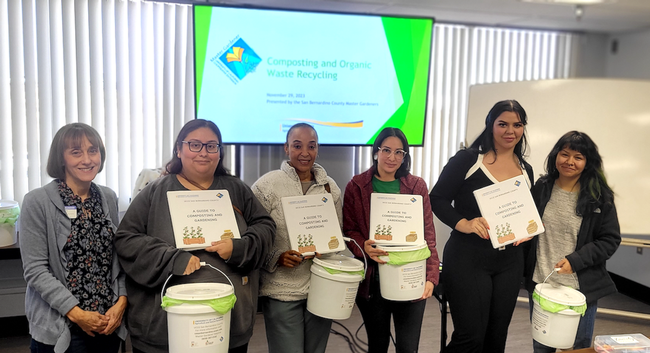
- Author: Michael Hsu
Tehama County students empowered by CalFresh Healthy Living, UCCE educator and teachers
It's not uncommon for high school or college students to speak up and seek to improve their school environment. But at Evergreen Middle School in Tehama County, more than 100 sixth graders led the way to create healthy changes at their school.
As part of their health classes during the 2022-23 school year, the students researched the availability of spaces for physical activity, developed a survey gauging their peers' health awareness and needs, analyzed the results and data, and made recommendations for improvements.
“We learned that there's not a lot of places – except for Evergreen Middle School and some other parks around [our community of] Cottonwood – that have many physical activity places that you can easily get to or have access to,” said Bailey, one of the students.
They were guided by Mario Monroy-Olivas, a nutrition educator with CalFresh Healthy Living, University of California Cooperative Extension in Tehama, Shasta and Trinity counties. Locally administered by UC Agriculture and Natural Resources, CFHL, UCCE is one of the agencies in California that teaches nutrition to people eligible for SNAP (Supplemental Nutrition Assistance Program) – referred to as CalFresh Food in California.
Working alongside Evergreen teachers Roxanne Akers and Albert Estrada, Monroy-Olivas challenged the sixth graders to tackle a “Youth Participatory Action Research” project – a yearlong, multi-step undertaking typically designed for older teens.
“The fact that we're doing it with these younger kids, starting a lot sooner, I think it's super impactful for them to know that, together, collectively they can make huge changes that will create positive outcomes – not just for themselves but for an entire community,” Monroy-Olivas said.
Middle school students speak up at school board meeting
In February 2023, eight class representatives presented their findings to the Evergreen Union School District Board of Education. Speaking before the five-member board for 20 minutes, the young people were naturally a bit nervous.
“It was a little nerve-wracking at first, but it wasn't that bad, once we got up there and got it over with,” said Lilah, one of the presenters. “Me and a couple of my friends were doing pep talks and practicing what we were going to say.”
The students showed a composite map that they drew from their classes' investigation of spaces for physical activity in the area, and shared a brochure that outlined their research and survey results. In a survey of more than 80 of their peers, 92% of respondents said they needed more access to physical activity equipment during class breaks, recess and lunch.
“The board members were super impressed with the students, coming to the school board and doing this,” Monroy-Olivas said. “They said they haven't had students doing this kind of advocacy work; for them, it was a really big deal.”
In the end, the young people made a strong case for more water-bottle refilling stations, badminton equipment and balls for other sports, and stencils for schoolyard activities like hopscotch, four square and snail (a type of hopscotch game).
“We got almost everything we asked for, and the project we're working on now is to help put in the things we asked for,” said Lilah, adding that, during this current school year, the students (now in seventh grade) are working on acquiring the stencils and paint.
More than just equipment, students gain skills and confidence
While the promise of new gear is exciting for the youth, they are acquiring something even more valuable and enduring – a sense that they are empowered to make a difference in their community, according to Janessa Hartmann, UC Cooperative Extension community nutrition and health advisor for Tehama, Shasta and Trinity counties.
“Yes, it's important to want to do stencils and hydration stations and have more equipment,” Hartmann said, “but the bigger impact for the students is that they think: ‘Now I know that my health is important, now I know how to advocate for myself, and now I know that I can do that.'”
Monroy-Olivas said he observed tremendous growth in all the students, and especially in the self-confidence of the class representatives.
“I grew as a leader because I used to be really shy and hated talking in front of people, but through this project we're doing, this has really helped me be able to talk in front of crowds – and listen to others,” Lilah explained.
In a survey at the end of the sixth-grade project, the percentage of youth who answered “Yes, most definitely” to the statement “I want to make a difference in making my school/community healthier” jumped from 19% before the project to 44% after. And that percentage of “Yes, most definitely” replies jumped from 6% to 31% for the statement “I can use research results to come up with solutions or recommendations for making my school/community a healthier place.”
“We learned to promote what we want and try to get it as much as we can, so we can get more physical activities and more people can be included,” said Brian, another student working on the project.
“It's important so when we get older, we know how to voice our opinions and let people know what we're thinking,” added classmate Brooklynn.
Wishing that he had such an opportunity when he was growing up, Monroy-Olivas said he feels the students now know the power of their voice.
“I wholeheartedly believe that's the biggest win out of this whole project, that they're learning how to advocate for their own voice and change,” he said.
- Author: Michael Hsu
New law mandates at least 30 minutes of recess for K-8 public school students
Last year, while working on a bill that would require California public schools to provide at least 30 minutes of recess, State Sen. Josh Newman sought the latest research on youth physical activity. Newman, whose district encompasses parts of Los Angeles, Orange and San Bernardino counties, traveled to the Bay Area to see one of the leading experts in the field.
During several visits with Newman, Hannah Thompson – a Nutrition Policy Institute senior epidemiologist and an assistant research professor in the University of California, Berkeley School of Public Health – shared the most recent science.
Both the American Academy of Pediatrics and Centers for Disease Control and Prevention recommend that children have 20 minutes or more of daily recess. But, when asked about the current “state of recess” across California, Thompson said she only knew of anecdotal evidence at the state level.
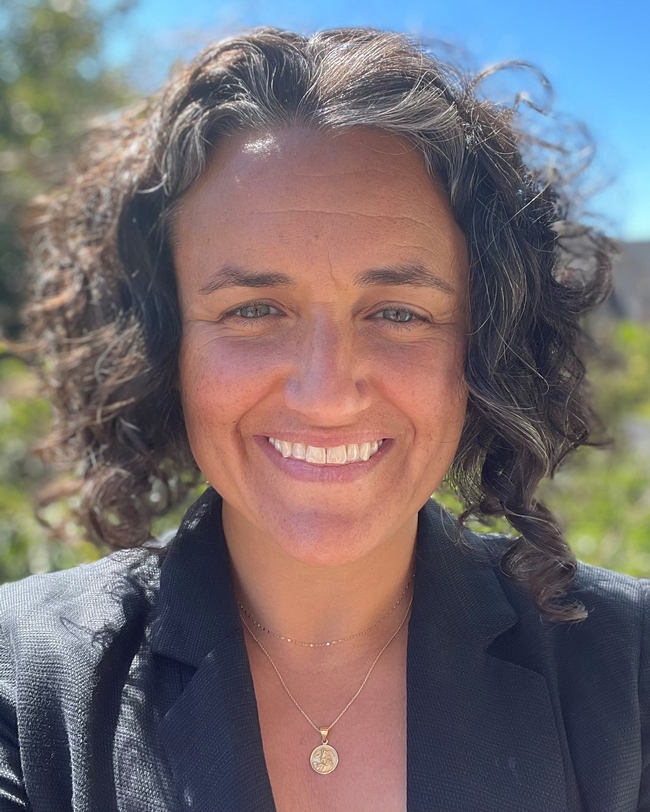
“I said, ‘You know what? I don't actually know what is going on in California,'” Thompson recalled. “I contacted a couple of colleagues who had done more national-level work on recess that included samples of California schools – but no one was really able to disaggregate what was happening in California.”
She brought up the bill during a meeting with her fellow researchers at NPI, an institute under UC Agriculture and Natural Resources.
And it turned out that Janice Kao, an NPI academic coordinator, had exactly what she needed.
CalFresh Healthy Living evaluation team provides key recess data
Kao leads a project team that evaluates local health departments' programs of CalFresh Healthy Living – California's version of the educational arm of SNAP (the federally supported Supplemental Nutrition Assistance Program).
As part of that evaluation process, Kao's team coordinates questionnaire administration at SNAP-Ed-eligible schools that are partnering with local health departments on CalFresh Healthy Living interventions, ranging from nutrition programs to physical activity initiatives. The survey asks school administrators about their current policies, environments and practices – including the provisioning of recess.
“It was just really good luck that everything was in the right place at the right time to be able to work together,” Thompson said.
At Thompson's request, Kao and her colleagues processed and cleaned that crucial piece of data, comprising responses from 153 low-income elementary schools in the 2021-22 school year.
“Just 56% of schools reported providing more than 20 minutes of recess daily,” Kao said. “So this was a situation where the data showed, ‘OK, there is some room for improvement, perhaps at that state policy level.'”
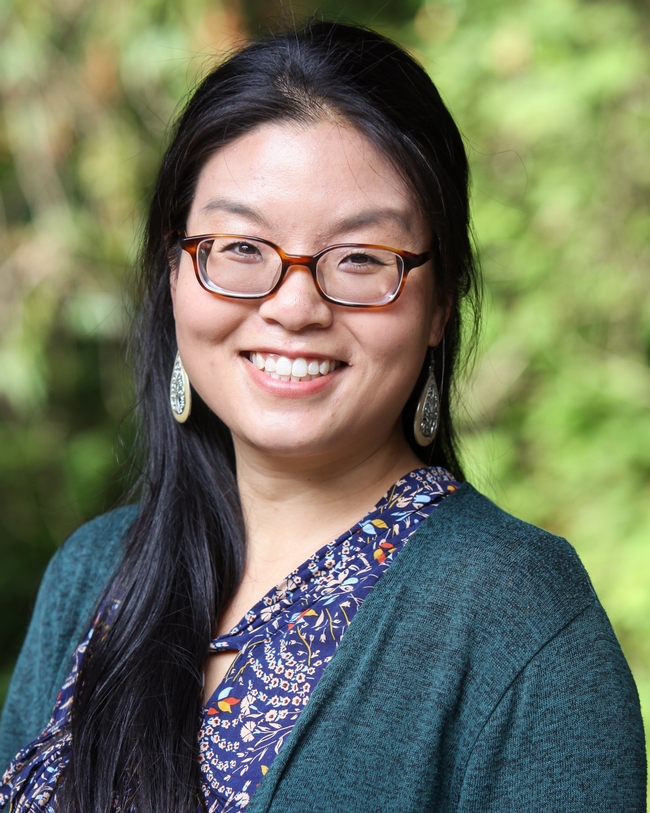
Thompson and Rebecca London, a sociologist at UC Santa Cruz, wrote a research brief detailing their analysis of the data. They describe disparities in recess time based on school size and income level of families, with students in larger, less affluent schools generally receiving less daily recess.
Thompson said those disparities are related to funding and academic inequities, as the imperative to boost test scores forced schools to increase certain classroom hours at the expense of recess time.
“We did all this work engineering physical activity out of the school day despite the tremendous body of evidence that shows physically active kids not only are healthier but can concentrate better; they have better academic performance, fewer disruptions, better classroom behavior,” explained Thompson, a former physical education teacher in Oakland. “In trying to address that academic gap, we ended up exacerbating a lot of these public health disparities.”
Virtual learning during the pandemic showed educators and parents – firsthand – the harmful effects of children staying sedentary in front of computer screens for hours. But the resulting momentum for restoring recess and time for physical activity was soon stalled as schools tried to make up for “lost time” in returning to classrooms, Thompson said.
NPI resources, expertise invaluable to lawmakers
Newman's bill, SB 291, was an attempt to lock in those recess minutes that are crucial for student health, development and scholastic performance. Both Thompson and London testified before the Senate Education Committee in April 2023, providing the senators with science-based information and context to guide their policymaking.
“Crafting policies rooted in science is critical for legislators to ensure our policies are impactful,” Newman said. “The work of Dr. Thompson and her colleagues at UC provided clear and useful guidance on the benefits of unstructured play and how to improve health and educational outcomes in California schools.”
Gov. Gavin Newsom signed SB 291 into law last October. Starting this coming school year, public elementary and middle schools across California will be required to give at least 30 minutes of recess to K-5 students – and prohibited from withholding recess as punishment.
Kao said her team was excited that their CalFresh Healthy Living evaluation data was useful for lawmakers, illustrating NPI's important role in informing evidence-based policy.
“I'm hopeful that we can use this same data set to also provide key pieces of information on other types of legislation that's in the works, or newly passed legislation,” Kao said.
Thompson said the challenge now will be ensuring schools have the resources and funding to provide quality time for young people.
“If you only have one schoolyard, and it's already dedicated to PE, what do you do now, if you have to increase your time for recess and you don't have that space?” she said.
Thompson added that she is currently applying for a grant to study how schools across California are adjusting to meet the new requirements.

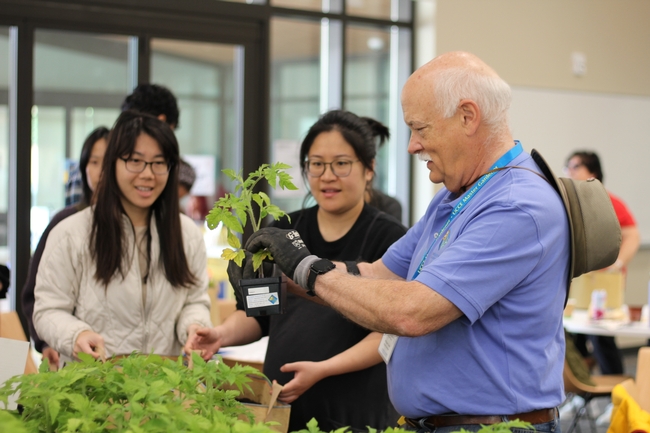
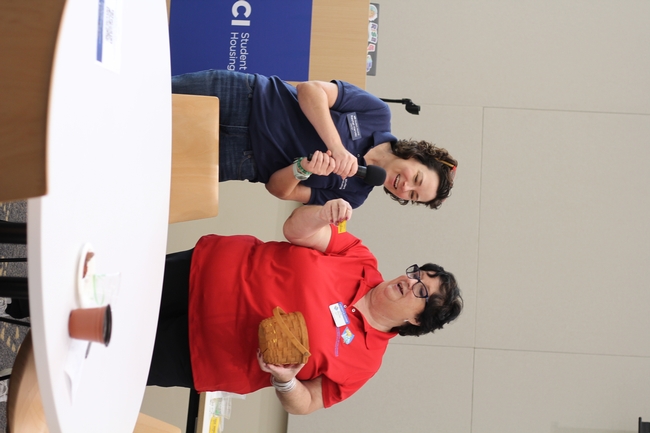
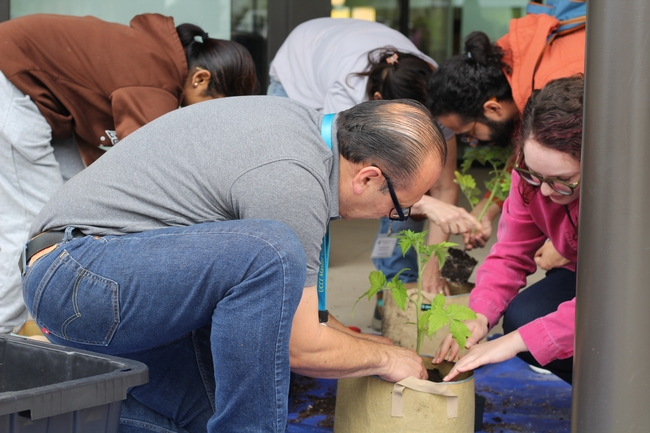
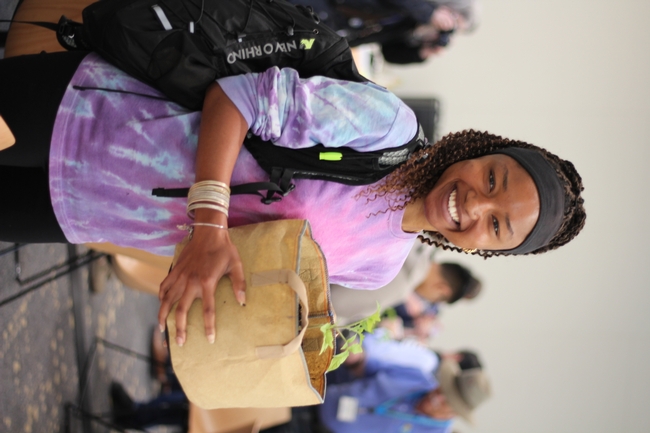
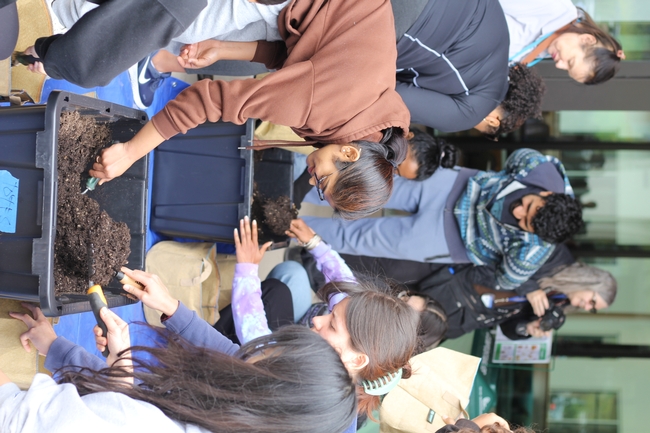
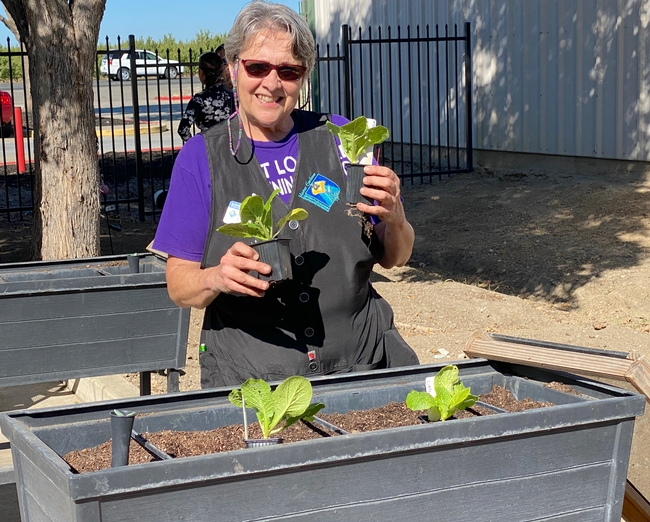
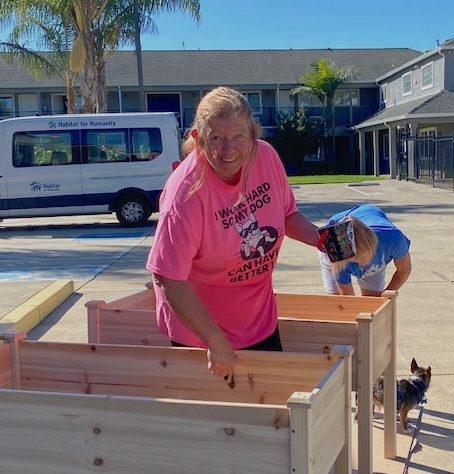
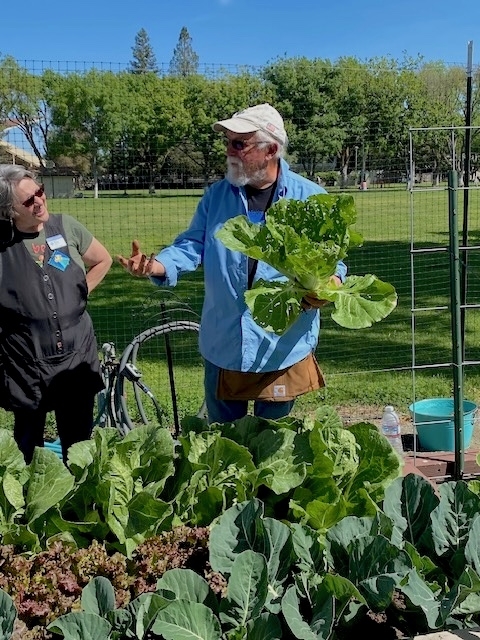
 Harmony Village IMG 0888[1](1)](http://ucanr.edu/blogs/Communities/blogfiles/106570.jpg)
